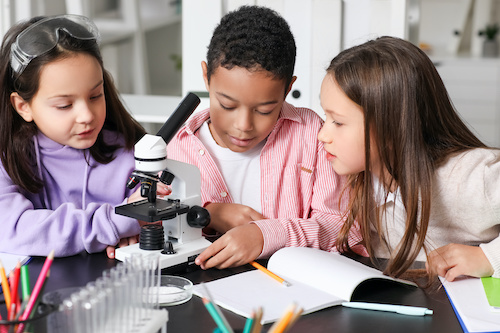Key points:
- PBL is a great way to meet a variety of student needs
- PBL can positively impact SEL by empowering students to feel in control of their learning
- See related article: How to make project-based learning a reality
- For more news on project-based learning, visit eSN’s Innovative Teaching page
As teaching–especially in the lower elementary grades–becomes increasingly
challenging with having to manage difficult behaviors, widely varied learning needs,
and skill deficits still lingering from the pandemic, project-based learning (PBL) may
arguably be the most underutilized resource to accommodate these needs.
PBL is not a new concept; in fact, education research articles refer to the idea, though in a much broader sense, beginning in the 1970s. The pedagogical method has since evolved into just that–its own pedagogical approach to bringing learning to life for students through hands-on engagement that lends itself to both differentiation and personalization.
The name can sound daunting to teachers and students alike. Teachers may shy away from PBL out of concern that it will take too much time or require a significant degree of preparation in addition to standard curricular planning. Students may similarly find themselves stressed at the mention of a project or feel defeated if they do not understand a concept and have to complete a project on it. In the early elementary grades, the assumption that PBL is simply too much for young learners can be a frequent roadblock.
However, PBL is one of the most sensible solutions to the variety of needs teachers
must try to meet for each student because it allows student autonomy and targets
specific areas. The concept hinges on the idea that students complete a project on a
single topic–ideally, they choose their own topics to promote interest and motivation–and, in doing so, dive deeply into that topic, ultimately becoming an expert on it.
Projects can be individually completed or a collaborative effort, promoting group work
and social skills. Because students control their learning in the PBL approach,
differentiation is simple, if needed at all, as students conduct their own learning at their own pace and present their learning in a mode that makes sense to them.
The outcomes of PBL exceed academic achievement, as researchers have found that it can also positively impact social emotional learning by empowering students to feel in control of their learning at school, improve students’ learning environments by
teaching them to manage their learning effectively, and teach students the value of
learning by allowing them to engage in meaningful tasks instead of worksheets they
may find pointless or boring. One of the most significant benefits of PBL is that it
addresses students’ questions as they learn, fostering curiosity and perseverance in
learning as opposed to having to stick to a specific curriculum.
So, how does PBL fit into elementary classrooms and work when implemented with the youngest learners? In their recent book Pedagogy of Play, researchers Mardell et al., identify play as a “cousin” of PBL, explaining that the two are closely linked. Describing play as an essential component of learning among young students, researchers suggest that PBL allows young learners to explore a topic–that is, to play with it and learn through the process. They write, “When a person has experiences that are joyful, meaningful, actively engaging, iterative, and socially interactive–in other words, playful–areas of the brain are activated, and chemicals are released, that are related to focused attention, memory, and movement from effortful to automatic learning.” PBL encourages “What if?” questions, leading to meaningful and interactive explorations of a topic that yield learning.
It is important to note that PBL is a pedagogical method, not a curriculum. It can
coexist alongside curriculums, enriching and supporting them, but it is a way of
animating academic content, inviting students to learn about what interests them using, practicing, and honing taught skills to conduct research, think critically, and
demonstrate their understanding.
In an elementary classroom that may include neurodivergent learners, students with
SEL needs inhibiting productivity, and more, this approach invites teachers to teach
basic skills and provide any necessary guidelines but then instruct to individual needs once PBL is underway.
Some ideas of what PBL might look like in a first grade
classroom include:
- A group of strong readers begin reading nonfiction books about a topic of their choosing and write their own story about the topic. They then work together to combine their stories and create a mini encyclopedia.
- A student struggling with basic math concepts creates and keeps track of a class “Lost Tooth” graph and practices counting and comparing numbers each time a classmate loses a tooth.
- A student who struggles to focus and seeks opportunities for movement listens to read alouds on a tablet about a topic of his choosing and practices sentence writing while writing about what he learns.
- A student gifted with artistic talent and excellent fine motor skills but who struggles to write creates detailed illustrations about a topic she chooses and practices labelling them to encourage writing.
These ideas are simple but relative to first grade, indicating that a PBL approach does not have to be a months-long endeavor that is unrealistic or impossible to fit in a schedule. On the contrary, it is a pedagogical approach that elementary teachers
should use more so as to meet students needs with greater ease while supporting
interest in learning.
- 4 ways to encourage play in education - April 25, 2024
- CoSN IT Leader Spotlight: Lisa Higgins - April 25, 2024
- It’s time to pay student teachers - April 25, 2024

